Living in a cozy space doesn’t mean sacrificing style or comfort—especially when you know the right tricks to make a small bedroom feel spacious and inviting. Small room bedroom ideas are trending because they help maximize every inch of limited space, transforming tiny rooms into personal retreats that are both functional and beautiful. Whether you’re working with a compact apartment or just want a more efficient layout, clever design can make all the difference.
In this article, you’ll discover a variety of smart, stylish ideas to elevate your small bedroom. From space-saving furniture to creative storage solutions and charming decor tips, there’s something for every taste and layout. Get ready to be inspired and learn how to turn your small space into a cozy, comfortable haven that feels larger than life!
1. Use Multi-Functional Furniture to Save Space and Enhance Comfort
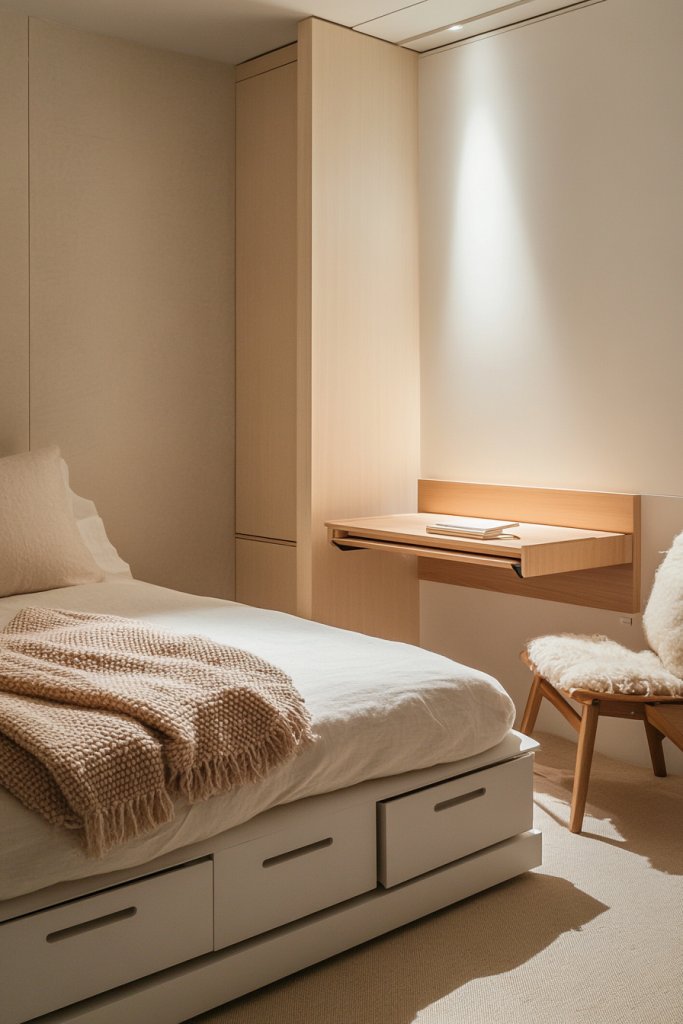
Living in a small room often feels like a constant battle between wanting comfort and needing practicality. When every inch counts, choosing furniture that does double duty can make all the difference. It’s frustrating to sacrifice style for storage, but what if you could have both? The right multi-functional pieces help maximize your space without sacrificing coziness.
Imagine a sleek bed frame with built-in drawers underneath or a fold-away desk tucked into a wardrobe wall. Think of a plush ottoman that opens up to reveal hidden compartments for blankets and books. These furniture pieces blend seamlessly into your decor, with soft fabrics and warm finishes that invite you to sink into comfort. Bright cushions and textured throws add personality without cluttering the space.
You can tailor these ideas to match your vibe—minimalist, boho, or industrial. Use neutral tones for a calming effect or mix bold colors for a playful look. For seasonal changes, swap out covers or accessories to keep the furniture feeling fresh. Smaller apartments benefit from wall-mounted fold-out desks, while larger rooms can handle convertible sofas that serve multiple purposes.
Start by measuring your space carefully and selecting furniture with multiple functions. Look for beds with integrated storage or desks that fold flat against the wall. Use sturdy materials like engineered wood or metal for durability. Assemble with basic tools—most multi-functional furniture comes with clear instructions. Prioritize pieces that are easy to clean and maintain, and consider modular options for flexibility. Focus on pieces that don’t overwhelm the room visually to keep the space feeling open.
Add your personal touch with colorful cushion covers, textured throws, or decorative trims. Incorporate removable slipcovers for easy cleaning and seasonal updates. Use decorative baskets or fabric bins to organize accessories inside storage compartments. You could even paint or customize furniture surfaces with fun patterns or colors that reflect your personality, making the space truly yours.
Multi-functional furniture transforms small rooms into efficient, stylish retreats that cater to your lifestyle. It’s a smart investment that boosts both comfort and functionality. Once you see how clever storage and adaptable pieces work together, you’ll wonder why you didn’t do it sooner. Your space will feel larger, more organized, and inviting, inspiring you to enjoy every square inch.
2. Opt for Soft, Layered Bedding for a Luxurious Feel
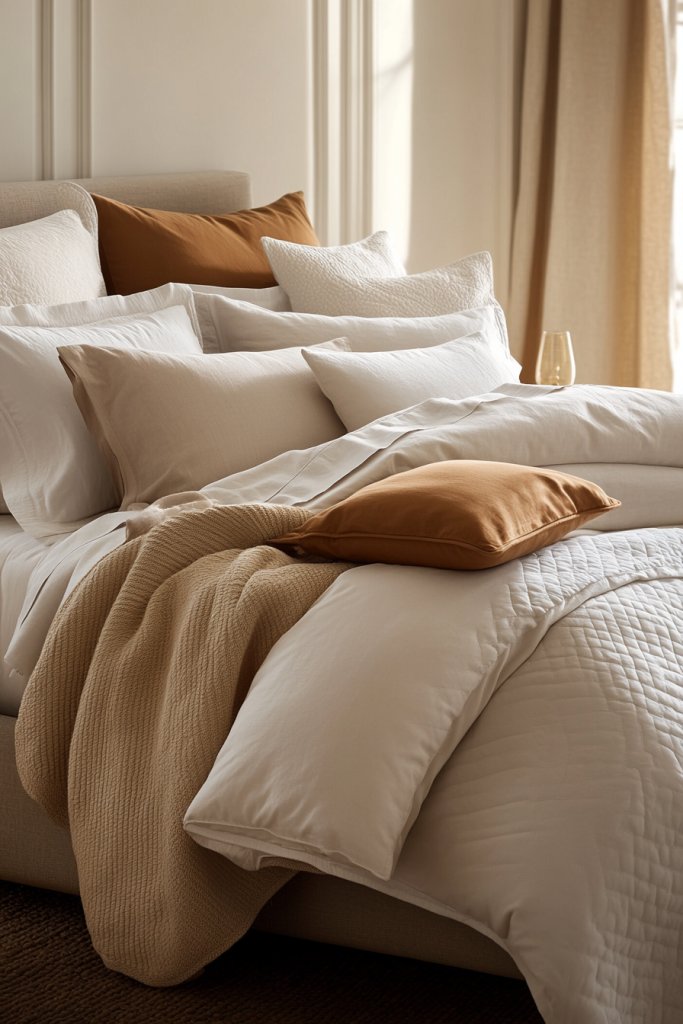
A small bedroom can easily feel cramped or uninviting if the bedding isn’t thoughtfully chosen. You want to create a cozy, luxurious retreat that makes you want to curl up and stay a while. But achieving that plush, inviting look without overwhelming the space can be tricky. The secret lies in layering soft textiles that add depth and comfort.
Picture a bed dressed in a fluffy white duvet with a textured cream throw blanket folded at the foot. Pile on a variety of pillows—some with velvet covers, others with chunky knits—that invite you to sink in. Soft lighting reflects off satin or silk pillowcases, enhancing the sense of luxury. The overall effect is a haven that feels both sumptuous and restful, even in a compact room.
Adjust your bedding layers based on the season—cotton sheets and lightweight quilts for summer, plush memory foam toppers and cozy throws for winter. Use a neutral palette for a calming environment or incorporate bold patterns and colors for personality. Mix textures like velvet, linen, and faux fur for visual interest without cluttering. For a minimalist look, stick with a monochrome scheme and subtle textures.
Choose high-quality, breathable fabrics that feel good against your skin and last over time. Start with a fitted sheet, add a plush duvet or comforter, and layer with decorative pillows and throws. Use a variety of textures to add depth—think a silky pillowcase paired with a chunky knit cushion. Keep the layering simple but deliberate, avoiding overcrowding the bed. Wash and refresh your bedding regularly to maintain that fresh, luxury feel.
Personalize your bedding with embroidered initials, or choose seasonal colors that reflect your mood. Incorporate a favorite scent—like lavender or vanilla—through scented sachets or sprays for added relaxation. Mix and match pillow shapes and sizes for varied visual appeal, and consider adding a decorative bolster for extra style points. Use a complementary rug or textured blanket nearby to enhance the tactile experience.
Soft, layered bedding turns a small bedroom into a sanctuary that screams comfort and style. It’s surprisingly affordable and easy to update with new textiles or colors. Once you indulge in plush textures and thoughtful layers, you’ll look forward to winding down every night. This simple upgrade can elevate your entire mood and create a space you love to relax in daily.
3. Incorporate Ambient Lighting with Dimmable Fixtures
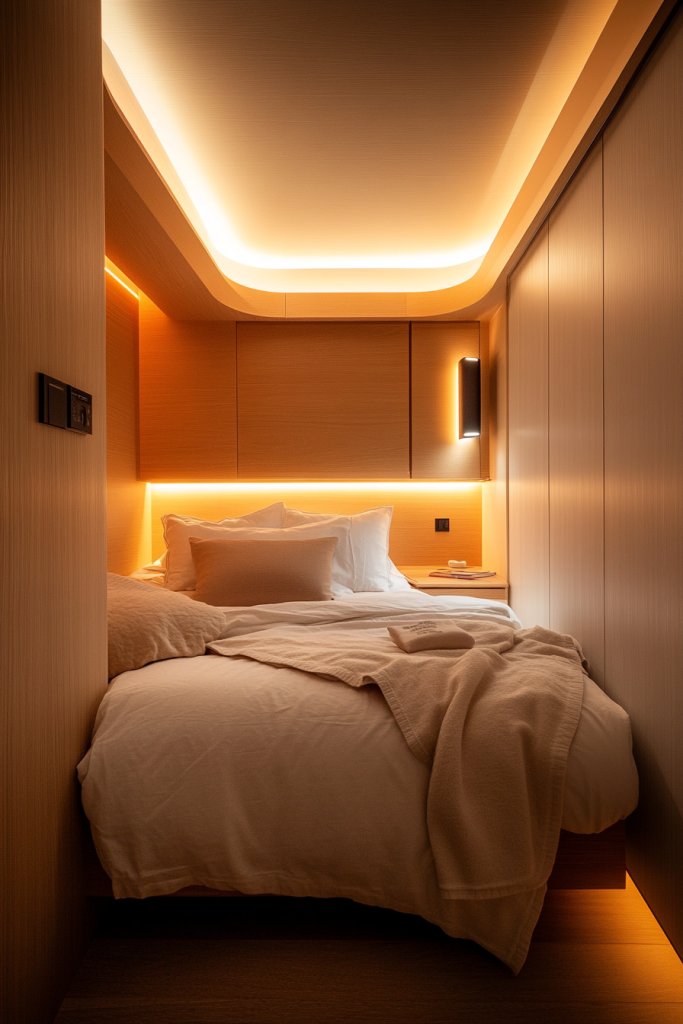
Small rooms often lack the proper lighting to set a relaxing mood or create a sense of warmth. Harsh overhead lights can make the space feel clinical or uninviting, especially when you want to unwind. The solution? Ambient lighting with dimmable fixtures that let you control the mood at the flick of a switch.
Imagine soft glow from wall-mounted sconces casting gentle shadows, or fairy lights draping over a headboard to create a starry effect. A table lamp with a textured shade adds a cozy pool of light perfect for reading or winding down. Dimmable switches allow you to adjust brightness easily, transforming the room from lively to restful. Warm-toned bulbs make everything feel more inviting, with a subtle glow that beckons you to relax.
Choose fixtures that match your decor style—sleek modern sconces, vintage-inspired lamps, or minimalist LED strips. Use smart bulbs for customizable color options, or incorporate candle-like LED candles for a flickering effect without the fire risk. For seasonal vibes, switch to warmer or cooler light temperatures. Installing dimmers on existing fixtures is a simple way to upgrade your current lighting setup.
Start by selecting fixtures that fit your room’s scale—small sconces or clip-on lights work well in tight spaces. Mount sconces at eye level or slightly above to create even, flattering light. Use adjustable lamps or fixtures with dimmer switches to control brightness. Consider placement carefully—avoid direct glare into your eyes or shining into the room’s corners. If you’re not comfortable wiring, hire an electrician for a clean, safe installation. Use warm white bulbs for a cozy vibe, or experiment with color-changing LEDs for variety.
Add decorative dimmer switches that match your room’s hardware, or incorporate portable lanterns for flexible lighting. Use dimmable string lights behind a fabric panel or inside a decorative frame to add visual interest. Layer different types of lighting—task, accent, and ambient—to make the room feel complete. Personal touches like a vintage lantern or a ceramic lamp can serve as statement pieces while providing soft light.
Ambient lighting transforms a small room into a cozy sanctuary that adapts to your mood and needs. It’s a simple upgrade that makes a huge difference in how your space feels. Once you master controlling light levels, you’ll enjoy your room more—whether for sleeping, reading, or relaxing. This small change can elevate your entire living experience and make your space feel instantly more welcoming.
4. Install Floating Shelves for Storage and Decor
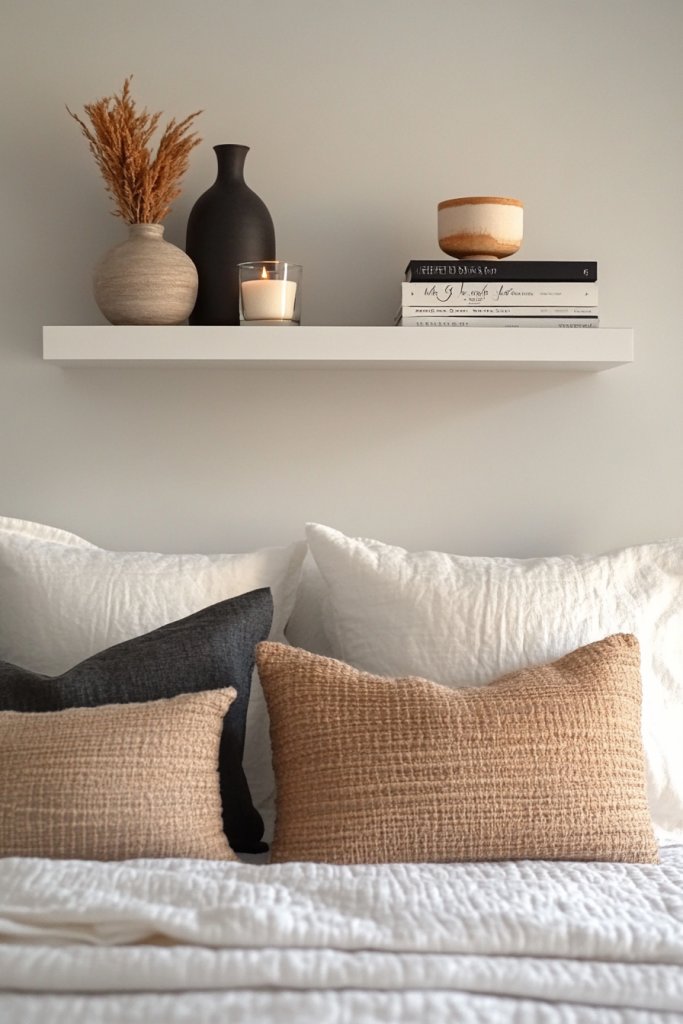
Clutter in tiny rooms can make even the most stylish space feel chaotic and cramped. You want to keep things organized without sacrificing style or taking up precious floor space. Floating shelves are the perfect solution—they add storage and display space without bulky furniture. Plus, they look sleek and modern, making your room feel more open.
Visualize a set of slim, matte-finish floating shelves mounted above your bed or beside a compact wardrobe. They hold neatly folded clothes, books, or decorative boxes, maximizing vertical space. You can display personal items like framed photos, candles, or small sculptures to add personality. The shelves seem to float effortlessly against the wall, creating a minimalist yet functional focal point. The overall effect is an organized, airy ambiance that invites calm.
Choose floating shelves in different finishes—wood, metal, or glass—to match your decor. For a cohesive look, keep items simple and symmetrical, or go eclectic with varied objects. Use brackets or hidden mounting hardware for a clean appearance. Incorporate seasonal decor—like cozy textiles or decorative trays—to keep the space fresh and inviting. Adjust shelf height based on what you’ll store or display for optimal functionality.
Start by measuring your wall space and selecting the right size and number of shelves. Use a level and a drill to ensure precise mounting—accuracy is key for a sleek look. Anchor shelves into studs if possible for stability, especially if you plan to hold heavier items. Keep the weight limits in mind and avoid overloading. Organize items neatly—group like with like—and leave some space for visual breathing room. Regularly dust and check the mounting hardware to maintain safety and appeal.
Add decorative elements like small potted ceramics or textured storage boxes. Customize the look with color-coordinated objects or themed arrangements. Incorporate LED strip lighting underneath a shelf for subtle illumination. Swap items seasonally to keep the display interesting and engaging. Use the shelves to showcase souvenirs, vintage finds, or favorite books that reflect your personality.
Floating shelves help you turn clutter into curated displays that elevate your space. They’re easy to install and versatile, fitting any style from minimal to eclectic. Once you see how much more organized and stylish your room feels, you’ll wonder why you didn’t do it sooner. It’s a simple tweak that can make a big impact on your daily comfort and room’s vibe.
5. Choose Light, Neutral Colors for a Spacious and Calm Environment
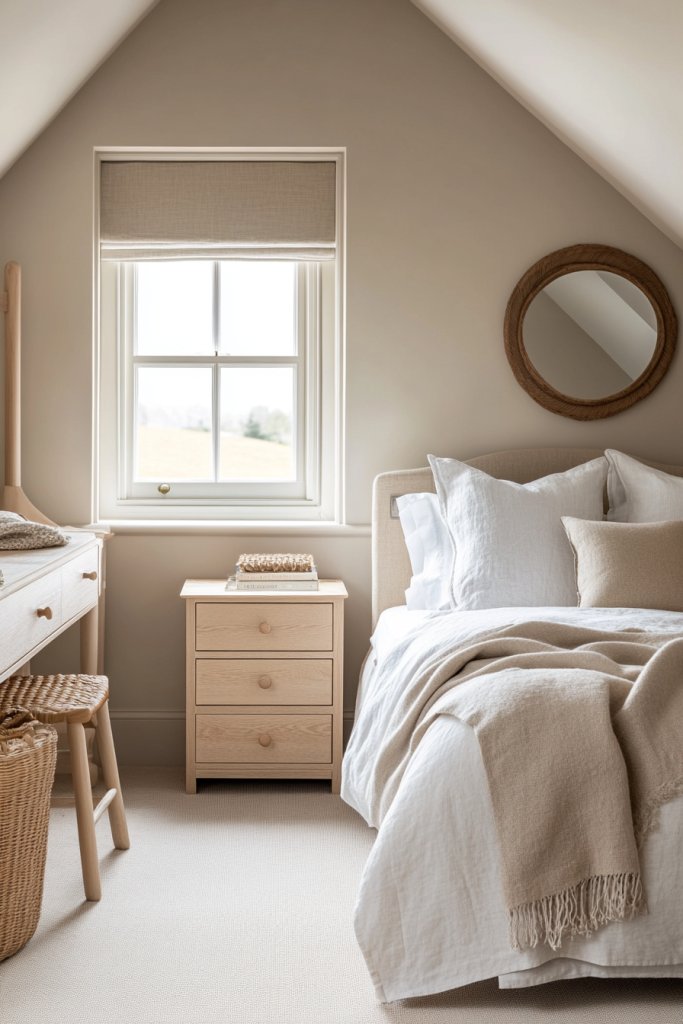
Small rooms often feel closed-in or overly busy when painted with dark, bold colors. You want a space that feels open, peaceful, and inviting—without a ton of effort. The trick is choosing light, neutral tones that reflect natural light and create an airy atmosphere. This simple color choice can dramatically change how your room feels.
Imagine soft beige walls that bounce sunlight around, making the room appear larger and more serene. Pair this with crisp white or cream bedding, textured textiles, and subtle accents in muted shades. The overall effect is a calming sanctuary, where every element complements the other. Light colors help the room feel uncluttered and fresh, even when space is limited. It’s like a breath of fresh air every time you step inside.
Neutral doesn’t mean boring—mix shades like taupe, blush, or pale gray for depth. Add pops of color through accessories or textiles, like a colorful throw or decorative cushions. For a cozy winter vibe, layer with warm-toned textiles; for summer, keep it cool and bright. These hues also serve as a perfect backdrop for personal decor, art, or statement furniture pieces. You can easily change accents without repainting.
Start with a light, neutral base paint—preferably matte for a soft finish. Use high-quality paint for durability and easy cleaning. Keep furniture and decor in similar shades or subtle contrasts to maintain harmony. Add layers of textiles—like a linen duvet, cotton curtains, or woven rugs—to soften the overall look. Incorporate mirrors and reflective surfaces to amplify natural light and enhance the sense of space. Regularly refresh accents to keep the environment lively.
Introduce subtle textures—think a plush rug or a quilted blanket—to add warmth. Use decorative trims or piping on textiles for a custom look. Hang minimalistic art or prints that complement the neutral palette. Keep clutter minimal, and choose storage solutions that blend seamlessly into the color scheme. Personal touches like a favorite cozy chair or a textured pouf can also enhance comfort.
A light, neutral color palette makes small rooms feel larger and more peaceful. It provides a versatile foundation for any style or season. Once you embrace these shades, decorating becomes easier, and your space instantly feels more inviting. It’s a timeless approach that supports relaxation and daily comfort, inspiring you to make the most of every inch.
6. Maximize Vertical Space with Tall Storage Units

Floor space is precious in small rooms, but vertical space often gets overlooked. You need clever ways to store your stuff without cluttering the floor. Tall storage units are your new best friends—they reach up to the ceiling and make use of every inch of wall. This approach keeps your room feeling open and organized.
Picture a towering bookcase filled with neatly arranged books, baskets, and decorative boxes. Or imagine a tall wardrobe with sleek doors that hide away clothes and accessories. These units add height to the room, drawing the eye upward and creating a sense of grandeur. The vertical lines add structure and contrast, making the room feel taller and more spacious. They’re both functional and aesthetically pleasing.
Choose units that match your decor style—sleek laminate, rustic wood, or modern metal. Use open shelving for easy access or closed cabinets for a tidy look. Incorporate modular units that you can customize over time. For added flair, mix in some decorative baskets or bins for hidden storage. Place taller units strategically to balance the room and maximize flow.
Measure your wall space carefully to select appropriate tall units. Secure heavy shelves or cabinets into wall studs for safety, especially if storing heavy items. Use a level and proper tools for installation to ensure stability. Organize items logically—clothes, books, or supplies—using boxes or dividers inside cabinets. Keep the area clean and dust-free, and periodically reassess your storage needs to avoid overloading.
Add decorative elements like colorful baskets, patterned boxes, or textured finishes to make storage stylish. Use labels or tags to keep things organized and easy to find. Incorporate lighting—like LED strips or spotlights—to highlight your tallest units. Customize interiors with removable shelf liners or decorative accents that reflect your personality. Regularly update your organization system to keep it fresh and functional.
Maximizing vertical space transforms your small room into a multi-layered haven of order and style. It frees up floor space for a cozy seating area or workspace. Once you see how tall storage units streamline your belongings, you’ll wonder how you managed without them. This smart approach boosts confidence in your decorating skills and makes your room feel bigger and more inviting.
7. Create a Cozy Nook with a Compact Reading Corner
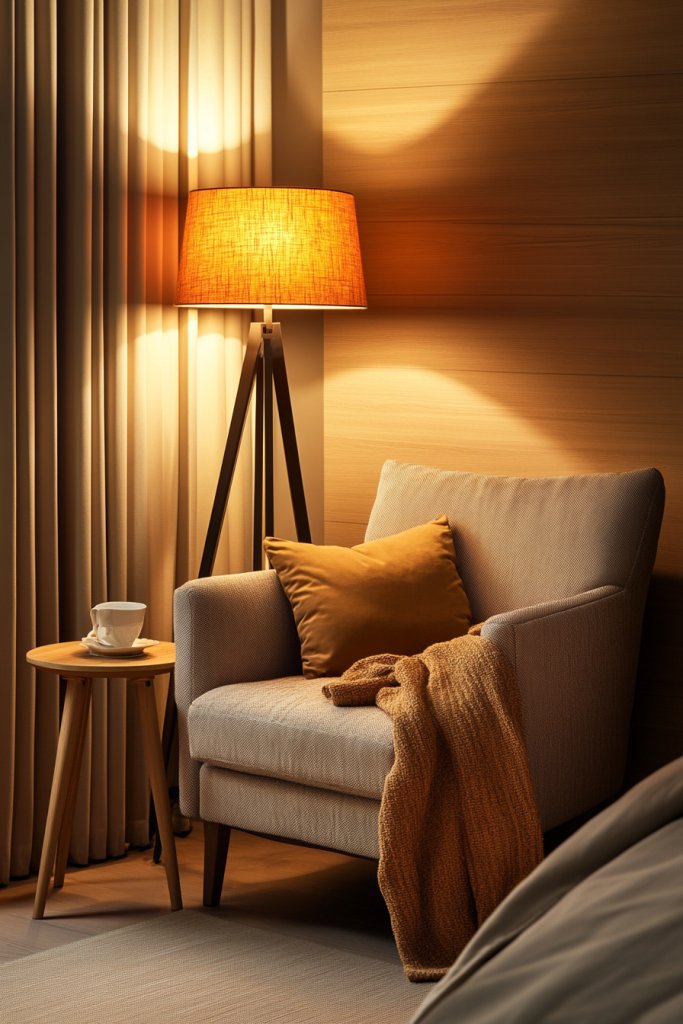
Small rooms often lack a dedicated space to unwind, read, or reflect. You want a cozy retreat that feels inviting without taking up too much room. Creating a compact reading nook is a simple way to add comfort and personality. It transforms a corner into your personal sanctuary where you can escape from daily chaos.
Envision a small corner with a plush armchair or window seat draped with a soft cream throw. Add a textured cushion or two for extra comfort. A small side table holds your favorite mug or a good book, while a wall-mounted shelf nearby displays your beloved reads or decorative objects. Warm lighting—like a small LED clip lamp or a candle—completes the scene. The space feels intimate, calm, and perfectly tailored for relaxation.
Use different seating options—an upholstered chair, a window bench, or even a floor cushion with a low table. Incorporate layered textiles—knitted throws, velvet cushions, or faux fur rugs—to boost coziness. Adjust the setup seasonally; add extra blankets or replace cushions with different textures. For a minimalist style, keep decor simple and focus on comfort-enhancing textures and soft lighting.
Identify a cozy corner—near a window or alcove. Choose a small, comfortable seat that fits the space, like a compact armchair or a padded window seat. Add a small side table or a stack of books for convenience. Use soft, warm lighting—think a clip-on lamp or string lights—to create ambiance. Decorate with textured fabrics and subtle accessories that make the nook inviting. Keep the area clutter-free to maintain relaxation.
Decorate with throw blankets in your favorite colors, textured cushions, or a small decorative tray. Personalize with a collection of your favorite books or vintage finds. Incorporate a small rug to define the space and add warmth. Use removable decals or framed photos nearby to make the corner truly yours. Regularly swap out textiles and accessories to keep the nook fresh.
A cozy nook adds a layer of comfort and charm to any small room. It’s your personal space to relax, read, or pause amidst a busy day. Once you establish your retreat, you’ll find yourself spending more time in your room, feeling more at ease. It’s a small investment with a big payoff in daily happiness and tranquility.
8. Use Mirrors Strategically to Reflect Light and Expand Space
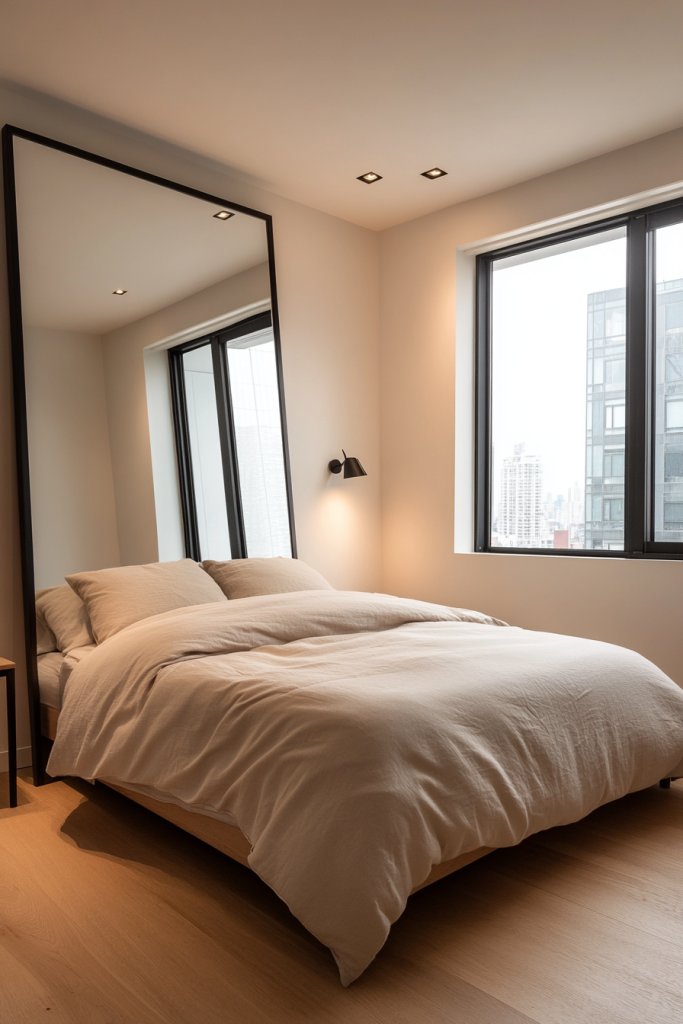
A tiny room can feel even smaller with poor lighting and a lack of visual depth. Mirrors are a simple, affordable trick to make your space appear larger and brighter. But the key is strategic placement—just hanging a mirror isn’t enough. Proper positioning can reflect natural light and create an illusion of space that’s truly impressive.
Imagine a large full-length mirror leaning against a wall or mounted across from a window. It reflects sunlight pouring in, bouncing it around the room and illuminating every corner. The mirror’s frame adds a decorative element—metallic, vintage, or minimalist—complementing your decor. When you walk into the room, the mirror visually doubles the space, making it feel open and airy. The effect is like magic, transforming a cramped room into a bright, welcoming haven.
Choose mirrors with decorative frames for more visual impact or sleek frameless designs for a minimalist look. Place mirrors strategically—above a dresser, across from windows, or behind a light source—to maximize their impact. For small rooms with limited wall space, consider mirrored closet doors or wall panels. Use multiple smaller mirrors grouped in an interesting pattern for a gallery effect. Adjust placement seasonally or as your needs change.
Measure your available wall space to select an appropriately sized mirror. Mount securely into wall studs or use heavy-duty anchors for safety. Place the mirror opposite windows to reflect maximum natural light. Clean the mirror regularly to keep reflections clear and bright. Experiment with angles and heights to find the most expansive effect. Consider a full-length mirror if you want to check your outfit or add visual depth.
Frame your mirror with decorative elements—like fairy lights, floral garlands, or metallic accents—to add personality. Use mirrored furniture, like a small table or storage unit, to amplify the reflective effect. Incorporate a standing mirror that can be moved around for flexibility. Add a decorative tray or sculpture nearby to complement the mirror’s style. Keep the surrounding area uncluttered for maximum impact.
Mirrors are simple yet powerful tools that instantly make your small room feel larger and brighter. They boost natural light and add depth, creating a space that feels more open and inviting. Once you see the difference, you’ll wonder how you ever lived without them. This easy upgrade can completely transform your room’s vibe and your daily mood.
9. Incorporate Soft Rugs or Carpets for Warmth and Sound Absorption
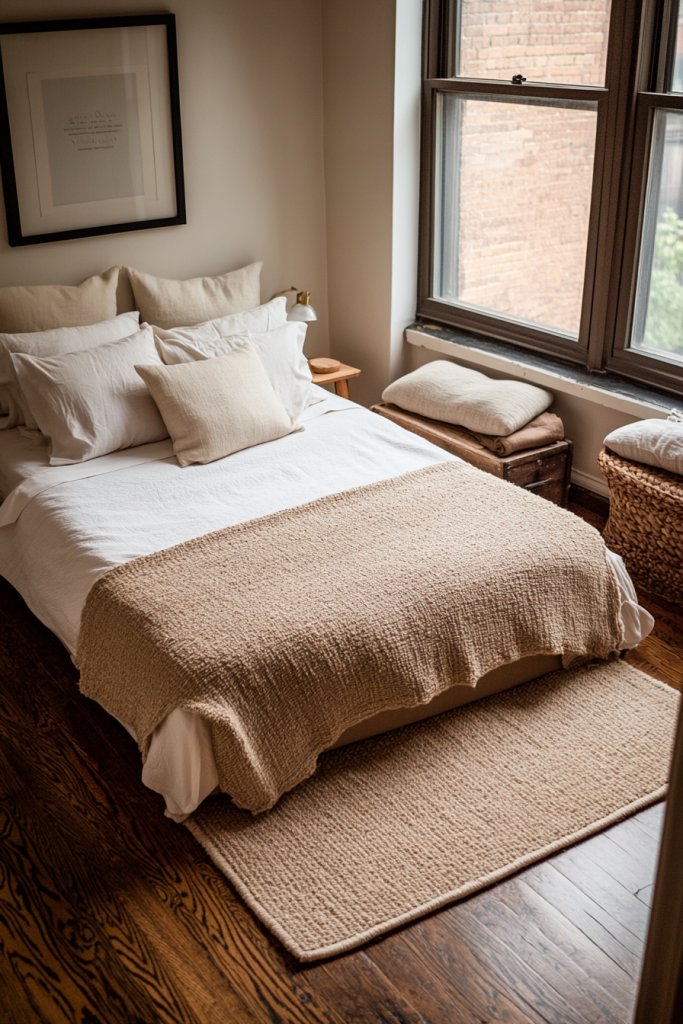
Hard flooring in small rooms can feel cold and echoey, making the space less cozy and more like a hallway. You want to add warmth underfoot and reduce noise to create a softer, more inviting atmosphere. A plush rug or carpet is the perfect solution—bringing comfort, style, and sound absorption all at once.
Picture a large, textured shaggy rug in a neutral tone, layered over a light wood floor. It creates a visual anchor for your bed and furniture, softening the overall look. The tactile experience makes the space feel warmer and more comfortable, especially in colder months. The rug also muffles footsteps and echoes, making the room quieter and more peaceful. Its plush surface invites you to walk barefoot and relax.
Opt for different textures—shearling, woven jute, or faux fur—to suit your decor style. Use a larger rug to define the entire sleeping or lounging area, or smaller accent rugs for a pop of color or pattern. Choose colors that complement your walls and furniture, or go bold with bright hues for contrast. Layering rugs can add depth and visual interest, especially in eclectic spaces.
Measure your space to find the right rug size—aim for at least 6 inches of border around your bed. Choose a high-pile rug for maximum softness, or a lower pile for easier cleaning. Place the rug centrally under your bed or seating area. Use non-slip pads underneath to prevent slipping and protect your flooring. Regular vacuuming and spot cleaning keep the rug looking fresh and inviting.
Add decorative trims or fringes to your rugs for extra flair. Incorporate a complementary color or pattern to tie the room together. Use textured cushions or throws to echo the rug’s tactile appeal. Seasonal updates—like swapping out a light summer rug for a plush winter one—keep the room feeling fresh. You can also layer smaller rugs for a more dynamic look.
A soft rug or carpet instantly adds warmth and comfort to a small room, making it feel more like a cozy retreat. It’s a simple change that can elevate your entire space, both visually and tactilely. Once you experience the plushness underfoot and the noise reduction, you’ll wonder why you ever overlooked this detail. It’s a small step that makes a big difference in daily comfort.
10. Add Personal Touches with Minimalist Wall Art or Prints
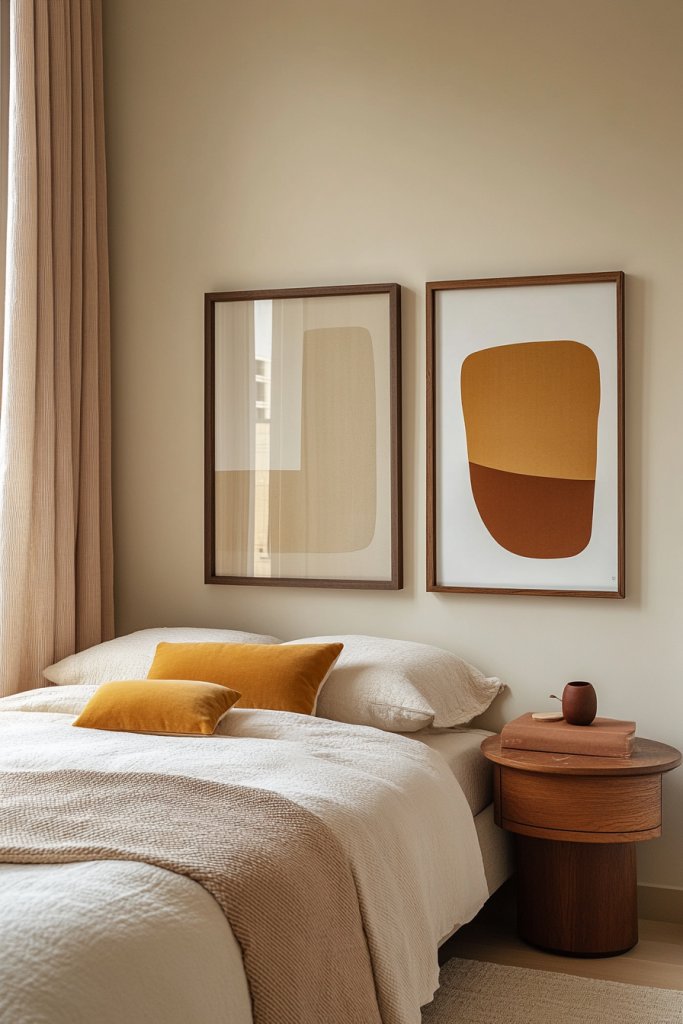
Your small bedroom can easily feel sterile or impersonal if it lacks personality. You want to make it uniquely yours without cluttering the limited space. Minimalist wall art and prints are perfect—they add visual interest and personality without overwhelming the walls. The trick is selecting pieces that reflect your style and keep the room feeling open.
Imagine a single large abstract print in muted tones hung above your bed, or a trio of small, framed black-and-white photographs arranged in a neat row. These simple additions draw the eye and create a focal point. Use sleek frames in black, white, or metallic finishes for a modern look that complements your decor. The artwork adds depth and personality, making the space feel curated and intentional.
Select art that matches your aesthetic—geometric patterns, botanical sketches, or minimalist line drawings. Keep colors subdued for a peaceful vibe or add a splash of bold hues for energy. Hang art at eye level for maximum impact, or create a gallery wall for visual interest. Change out prints seasonally or whenever you want a fresh look to keep the space dynamic.
Pick lightweight frames or canvas prints for easy hanging. Use command hooks or strips to avoid damaging walls, especially in rental spaces. Measure carefully and plan your layout before hanging. Keep the artwork simple and uncluttered—avoid overcrowding small walls. Consider layering art with decorative textiles or mirrors nearby for added dimension. Regularly clean the frames and glass to keep everything looking crisp.
Personalize with your favorite quotes, minimalist illustrations, or abstract designs that inspire you. Incorporate a series of small prints in matching mats for a cohesive look. Add a decorative shelf or ledge to rotate art, photos, or small objects that hold sentimental value. Use removable wall decals or decals with positive affirmations for a playful touch. Keep the overall aesthetic clean and uncluttered.
Minimalist wall art elevates your small bedroom from plain to polished with minimal effort. It’s a cost-effective way to introduce personality and style. Once you see how a single impactful piece transforms the space, you’ll feel inspired to keep personalizing. Your room becomes a reflection of you—calm, stylish, and uniquely yours.
11. Implement Hidden Storage Solutions for Clutter-Free Living
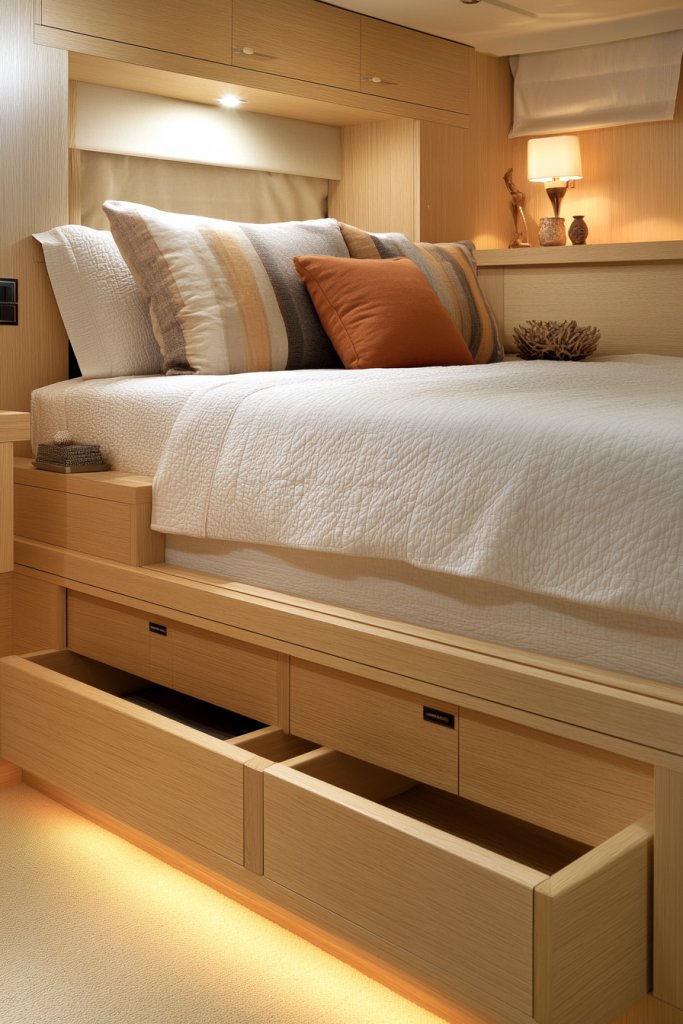
Clutter is the enemy of small rooms—every surface and corner seems to collect odds and ends. You crave a tidy, peaceful space but struggle with limited storage options. Hidden storage solutions can keep your belongings out of sight while maintaining a sleek look. They’re the secret weapon for clutter-free living in tight quarters.
Visualize a bed with built-in drawers underneath, seamlessly integrated into the frame. Imagine a mirror-fronted cabinet that hides away clothes or accessories, or a storage ottoman that doubles as seating. These clever solutions keep everyday items tucked away, reducing visual chaos. The result is a streamlined, organized space that feels larger and more calming. Every item has a home, and your room stays pristine.
Choose furniture with hidden compartments—beds, benches, or side tables—that match your decor style. Use storage bins or baskets that slide into custom-built cabinetry or under furniture. For wall storage, consider hidden compartments behind decorative panels or inside stair-step designs. Use labels or color coding to keep everything organized. Seasonal or occasional items can be stored in less accessible spaces, freeing up prime real estate.
Start by decluttering and identifying what needs to be stored out of sight. Invest in furniture with built-in storage or add custom drawers under your bed. Use high-quality, durable bins or boxes that fit inside these spaces. Install wall-mounted cabinets or hidden compartments—hire a professional if needed for complex carpentry. Regularly reassess your storage needs to avoid overstuffing and maintain accessibility. Keep your spaces tidy by returning items to their designated spots.
Decorate hidden storage with removable covers or decorative panels that match your room’s style. Use labels, tags, or color-coded bins to simplify organization. Incorporate multi-purpose furniture—like a storage bench with a decorative cushion—to blend function and style. Add a few personal touches such as a small collection or a favorite scent inside drawers for a sense of comfort. Keep some accessible storage for daily essentials and tucked-away options for seasonal or rarely used items.
Hidden storage solutions make small rooms feel spacious and orderly without sacrificing style. They empower you to keep clutter at bay and enjoy a cleaner, more peaceful environment. Once you see how well organized your space becomes, you’ll gain confidence in your decorating and organizational skills. It’s a smart, stylish way to maximize every inch of your small room.
12. Choose Compact, Space-Saving Nightstands or Side Tables
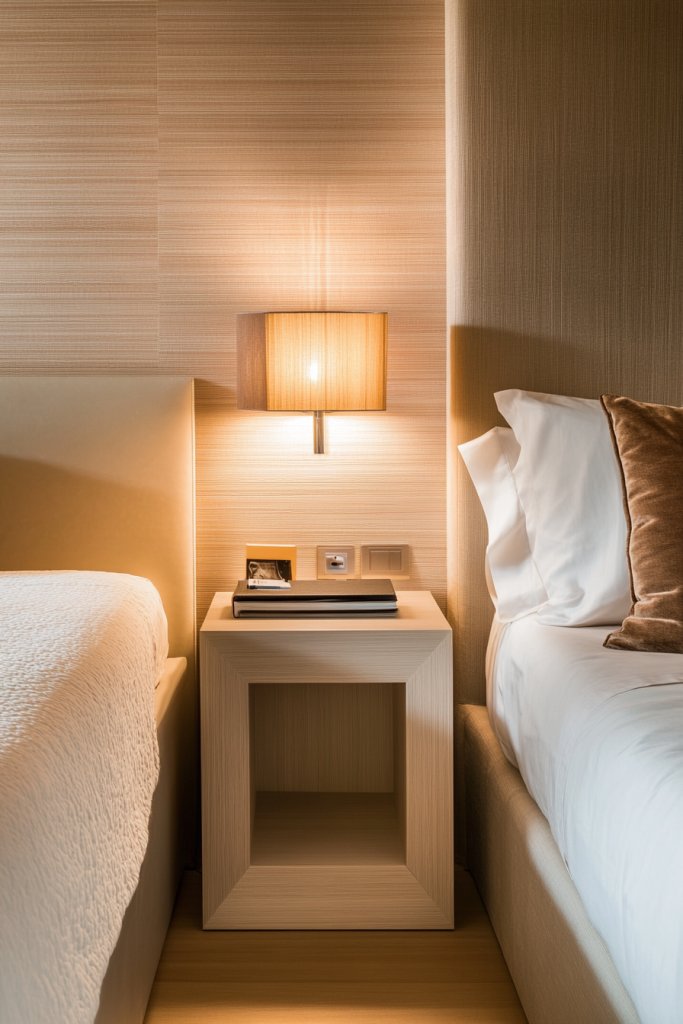
A small bedroom needs a nightstand, but bulky tables can crowd the space and disrupt the flow. You want a functional surface for essentials like a glass of water, phone, or a book—without sacrificing valuable space. Compact, space-saving nightstands or side tables are your solution. They keep things within reach while maintaining an open, airy feel.
Imagine a sleek, minimalist side table with a single drawer and open shelf, fitting snugly beside your bed. Or a floating wall-mounted unit that offers storage without taking up floor space. These pieces blend seamlessly into your decor, often with clean lines and neutral finishes. They provide just enough surface area for your essentials, leaving the rest of the room uncluttered. The overall vibe is modern, functional, and spacious.
Opt for designs that match your aesthetic—scandinavian simplicity, industrial metal, or vintage charm. Use multi-tiered options to maximize storage vertically. For a personal touch, choose a table with a textured surface or decorative accents. Consider multifunctional units—like a small bench with a hidden compartment—that serve as seating during the day. Size your table to fit your space and needs, avoiding oversized furniture.
Measure your space carefully and select a nightstand that fits comfortably without crowding the bed. Use wall-mounted options or floating shelves to save floor space altogether. Choose sturdy materials—wood, metal, or composite—that complement your decor. Keep surfaces clear except for essentials, and add small decorative elements like a tray or a tiny plant (out of the restricted items list!). Position the table close enough for easy reach but not so close it blocks movement. Regularly clean and organize to maintain a tidy look.
Personalize with decorative handles, textured finishes, or painted accents. Use storage baskets or boxes underneath for extra organization. Decorate the surface with a favorite book, a small sculpture, or a decorative tray—just avoid restricted items. Consider adding a small, fold-down table or a collapsible stool nearby for versatility. Keep the style consistent with your overall decor theme for coherence.
Choosing the right compact nightstand elevates your small bedroom’s style and functionality. It’s a simple upgrade that keeps your space feeling open and organized. Once you see how a well-chosen piece fits perfectly without crowding, you’ll feel more confident about your design choices. Small changes like this can significantly improve your daily comfort and room ambiance.
13. Incorporate Cozy Textiles like Throws and Cushions for Extra Comfort
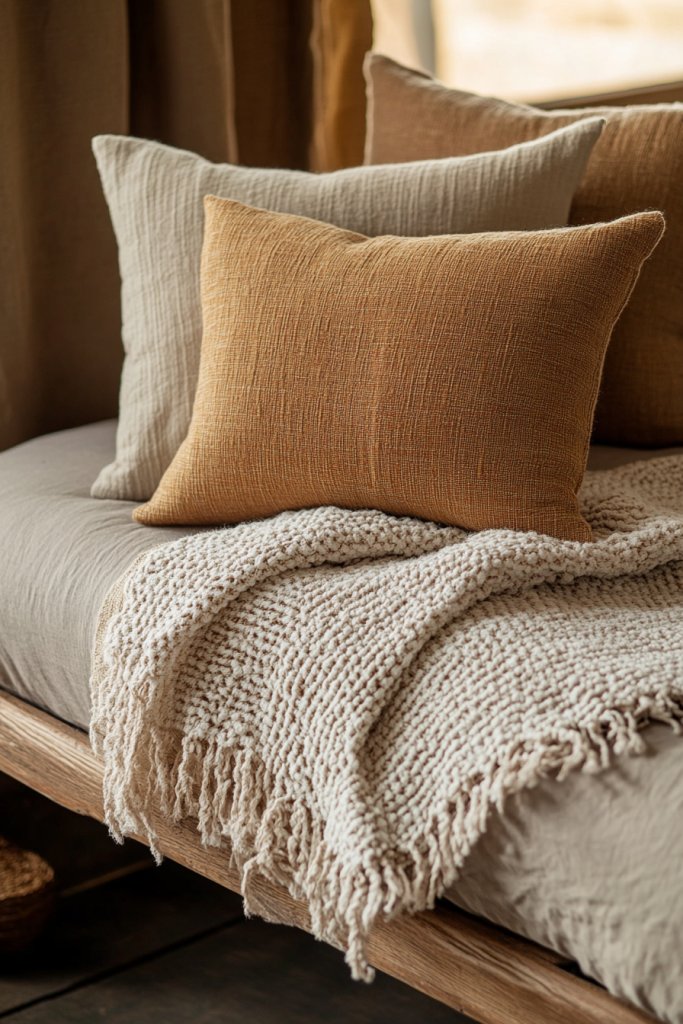
A small bedroom can sometimes feel stark or uninviting if it lacks tactile warmth. You want to create a space that feels cozy and welcoming, where every touch invites relaxation. The easiest way? Add soft textiles—throws, cushions, and blankets—that turn a plain room into a comfy retreat. They’re affordable, easy to swap, and instantly elevate the vibe.
Picture a bed layered with a plush cream throw in a chunky knit pattern, complemented by an array of cushions in varying textures and sizes. Think velvet, faux fur, and linen, creating a tactile tapestry that invites touch. Scatter a few cushions on a window seat or a cozy corner to add visual warmth and comfort. The textures catch the light subtly, adding depth to the minimalist decor. The overall effect is an inviting, layered look that’s both stylish and snug.
Mix textures to create visual interest—try combining silky, velvety, and woven fabrics. Use colors that complement or contrast your overall palette for a playful or sophisticated look. Incorporate seasonal textiles—light cottons for summer, thick knits or faux fur for winter. Change out cushion covers and throws periodically to keep the room feeling fresh and aligned with your mood.
Select cushions in various sizes and textures—think a large velvet bolster or a small faux fur square. Layer them on your bed or a reading nook for comfort and style. Use throws in different fabrics and weights, folding or draping them casually. Wash and maintain textiles regularly to keep them looking plush and inviting. Match or contrast colors for harmony or visual pop, depending on your style. Keep accessories simple to avoid clutter.
Add decorative trims, embroidery, or tassels for a custom look. Incorporate favorite patterns or colors that evoke your personality. Use textiles with subtle shimmer or metallic threads for a luxe touch. Rotate seasonal cushions or throws to reflect your changing tastes or mood. Personal touches make the space more intimate and uniquely yours.
Soft textiles are a quick and effective way to add warmth, style, and comfort to any small bedroom. They’re versatile, affordable, and easy to change, making decorating fun and flexible. Once you experience how tactile layers transform your space, you’ll enjoy spending more time there. It’s a simple step toward creating your perfect cozy retreat.
14. Use Curtain Dividers to Define Different Areas
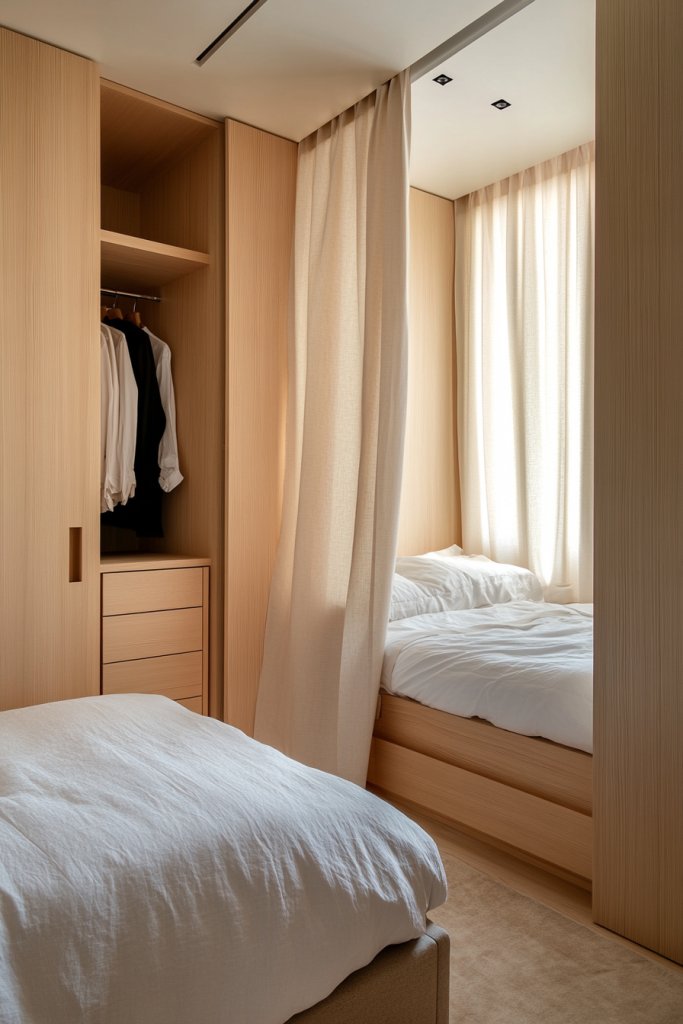
In small rooms, it’s hard to create visual separation between different zones like sleeping, dressing, or relaxing areas. Without clear boundaries, the space can feel chaotic or overwhelming. Curtain dividers offer a flexible, affordable way to carve out distinct areas without installing walls. Plus, they add a touch of softness and privacy to your tiny retreat.
Imagine a lightweight, flowing curtain hanging from a ceiling track, partitioning off your bed from a dressing area. It moves gently when you walk by, creating a subtle boundary. The fabric adds texture and color—think sheer in neutral tones or patterned for visual interest. When closed, it provides privacy and a sense of enclosure; when open, it maintains an open, airy feel. This simple addition instantly transforms your space into multiple functional zones.
Choose fabric that complements your decor—cotton, linen, or velvet for a cozy vibe, or sheer for a light, airy feel. Install ceiling-mounted tracks or tension rods for easy setup and removal. Use different colors or patterns to delineate zones, or keep it uniform for a seamless look. For a more dramatic effect, layer multiple curtains or add decorative trims. Seasonal or mood-based changes keep the space feeling fresh.
Measure your space and select a curtain length that suits your ceiling height. Install a ceiling track or tension rod securely, ensuring smooth operation. Hang your curtains in a way that allows easy access and movement. Choose fabrics that are easy to clean and maintain. Use ties or hooks to hold curtains open when you want an open feel. Regularly wash and adjust the curtains to keep the zones defined and clutter-free.
Decorate curtains with embellishments—like tassels, trim, or embroidery—to add personality. Use different fabrics for different zones—light and sheer for sleeping areas, heavier for dressing zones. Incorporate a curtain tie-back or decorative holder to keep the curtain open stylishly. Coordinate curtain colors with your overall decor theme for harmony. Rotate fabrics seasonally for a refreshed look.
Curtain dividers are a versatile way to create distinct zones in a small room, adding privacy and style. They’re easy to install and remove, giving you flexibility as your needs evolve. Once you see how they organize your space, you’ll feel empowered to experiment further. This simple solution enhances both function and aesthetic, making your room feel more spacious and intentional.
15. Install a Wall-Mounted Desk for a Functional Workspace
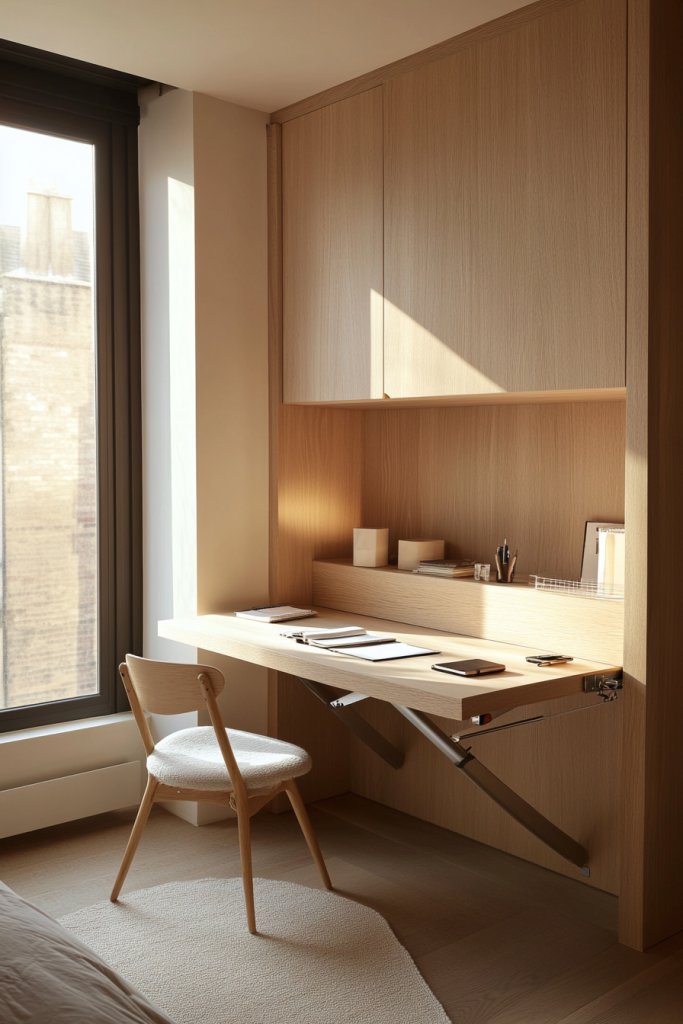
A small bedroom often lacks a dedicated workspace, making it hard to study, work, or pursue hobbies comfortably. A bulky desk can eat up precious space and clutter your room. The perfect fix? A wall-mounted desk that folds away when not in use. It’s a sleek, space-saving solution that keeps your room functional and clutter-free.
Picture a simple wooden or laminate fold-down desk mounted on a wall beside your bed. When folded, it becomes a clean, flat surface, barely visible. When needed, you pull it down, revealing a sturdy workspace with enough room for a laptop and a few supplies. Add a small wall shelf above for storage or decorative items. The space remains open and uncluttered, but ready to serve its purpose when you need it.
Choose materials and finishes that match your decor—light wood for a Scandinavian vibe, sleek black for modern, or painted for a pop of color. Use a slim-line fold-down desk or a wider unit depending on your needs. Incorporate modular storage solutions nearby to keep supplies organized. For a more personalized touch, add a corkboard or magnetic strip above for notes and accessories.
Start by measuring your wall space and selecting a fold-down desk that fits comfortably. Install brackets securely into wall studs for stability. Use a level to ensure proper alignment. When not in use, fold the desk up flat against the wall, and when needed, pull it down and lock into place. Clear the surrounding area of clutter to maximize workspace. Consider adding a small chair or stool that tucks underneath for minimal footprint.
Decorate the desk with a stylish mouse pad, a small plant (non-restricted), or decorative organizers. Use colorful or patterned fold-out covers to add personality. Add a corkboard or magnetic board for notes, photos, or inspirational quotes. Ensure the space around the desk is free of distractions for maximum productivity. Change accessories seasonally to keep the workspace fresh.
A wall-mounted desk enhances your room’s functionality without sacrificing style or space. It’s perfect for remote work, studying, or hobbies in a compact room. Once installed, you’ll appreciate how much more organized and efficient your space feels. Small changes like this can make a big difference in your daily routine and overall room vibe.
16. Choose Compact, Comfortable Seating Options
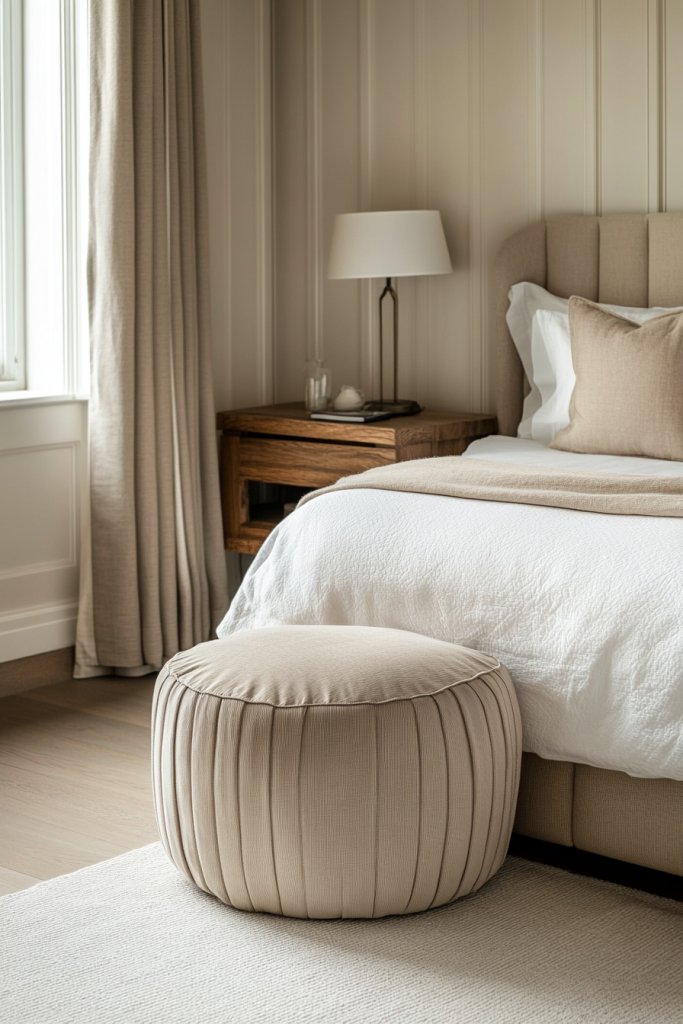
Your small bedroom needs seating, but large chairs or sofas just make the space feel cramped. You want versatile, comfortable options that don’t overwhelm the room. Compact seating like poufs, small armchairs, or floor cushions provide the perfect balance of comfort and space efficiency. They’re easy to move around and add personality.
Visualize a plush pouf in a bright color tucked beside your bed or in a corner. A small, sleek armchair with a textured throw invites you to sit and relax. Floor cushions with decorative covers can double as extra seating or staging for a casual gathering. These pieces add visual interest with their textures and shapes, creating cozy zones without blocking pathways or making the room feel crowded.
Mix and match different styles—think modern leather, boho woven, or vintage-inspired textiles—to match your decor. Use multi-functional pieces like a padded ottoman that also serves as storage. For seasonal updates, swap cushion covers or add throws that reflect your current style or mood. Keep colors light or neutral to maintain an open feeling, or go bold for a statement piece.
Choose small-scale furniture that fits your space—measure carefully before buying. Use lightweight options for easy repositioning, especially if you like to change layouts often. Place seating near your bed or by a window to create a cozy nook. Add textured covers or cushions for extra comfort. Regularly clean and fluff cushions to keep them inviting. Use versatile pieces that can serve multiple functions if space is tight.
Decorate with cushions in your favorite fabrics, patterns, or colors. Incorporate textured throws or decorative poufs for added warmth and style. Use small side tables or trays for convenience, and personalize with favorite accessories (avoiding restricted items). Layer different textures to add depth and interest. Rotate cushions or covers seasonally for a fresh look.
Choosing compact, cozy seating options elevates your small room’s comfort and style effortlessly. They’re versatile, affordable, and easy to update. Once you see how they transform your space into a welcoming retreat, you’ll gain confidence in your decorating choices. Small touches like these make your room more functional and fun to enjoy daily.
17. Keep the Space Open and Airy with Minimal Decor
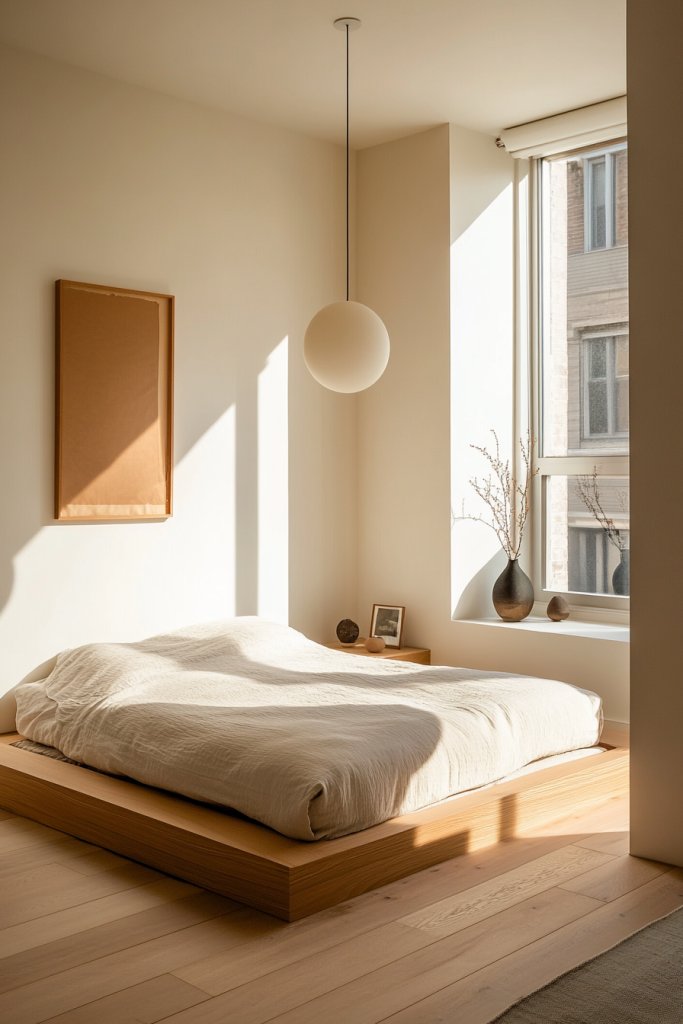
A cluttered or overly decorated small room can feel suffocating and chaotic. You want a space that breathes, feels calm, and invites relaxation. Minimal decor is the answer—focusing on quality over quantity. It creates a sense of openness and tranquility, making even the tiniest room feel larger and more inviting.
Visualize a room with just a few carefully chosen pieces: a sleek bed with simple bedding, a single wall mirror, and a couple of functional shelves. Keep surfaces clear, with only essentials or a few decorative objects. Use neutral tones and simple lines to emphasize space and light. The effect is a peaceful, uncluttered room that looks effortlessly stylish and spacious.
Limit your color palette to a few soothing shades—white, beige, soft pastels—for a calming atmosphere. Choose a few statement pieces—like a textured throw or a unique lamp—to serve as focal points. Keep accessories minimal and functional, like a small clock or a simple vase (if necessary). Regularly declutter and reassess your decor to maintain simplicity and serenity.
Start by removing excess furniture and decorations, keeping only what truly enhances the space. Use multi-purpose furniture to reduce clutter. Choose decor pieces with simple, clean designs and avoid busy patterns. Arrange furniture to maximize floor space and natural light. Limit accessories—each should serve a purpose or add value. Regularly tidy up to maintain the minimalist vibe.
Inject personality subtly with textured textiles, a favorite color accent, or a meaningful object. Use sleek storage options to hide clutter. Incorporate a few personal items, like a framed photo or a favorite book, in a way that doesn’t dominate the space. Keep your overall decor cohesive and balanced for a calm environment. Periodically refresh the space with small updates that reflect your evolving style.
A minimalist approach creates a room that feels larger, brighter, and more peaceful. It’s easier to maintain and more adaptable to changes in style or season. Once you experience the serenity of a clutter-free space, you’ll be motivated to keep your room simple and beautiful. Less truly is more—especially in small spaces—making your everyday environment more enjoyable and calming.
Conclusion
With a mix of clever layout hacks, multifunctional furniture, and decorative touches, these small room bedroom ideas provide a wealth of inspiration for maximizing comfort and style. Don’t hesitate to try out these tips and tailor them to your unique space—your perfect, cozy bedroom is within reach. Embrace the challenge and transform your small room into a haven where comfort and personality shine!
Leave a Reply